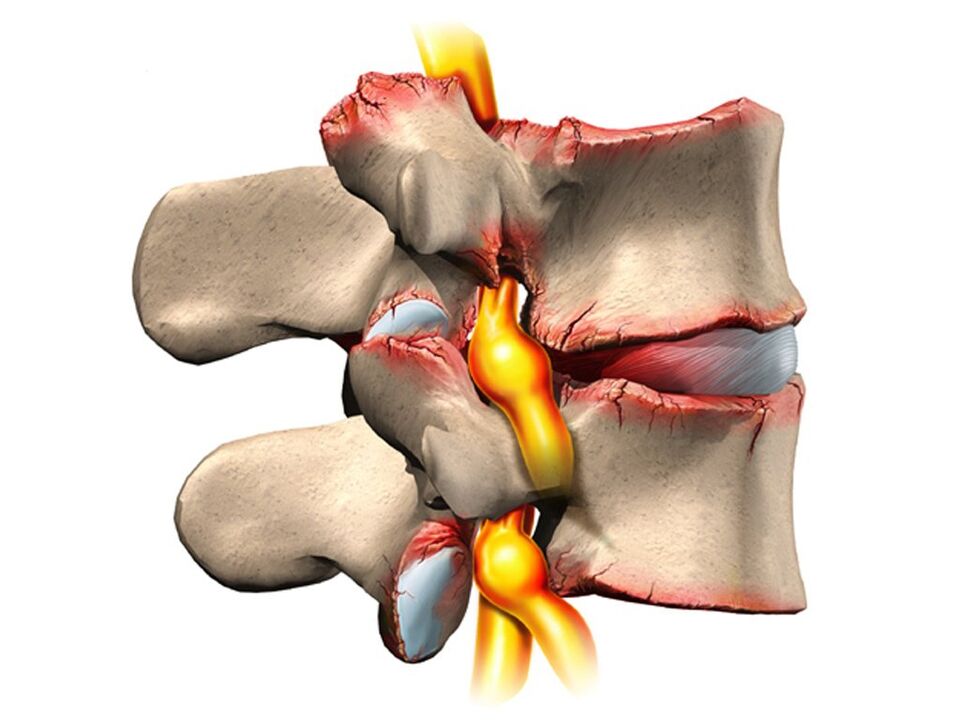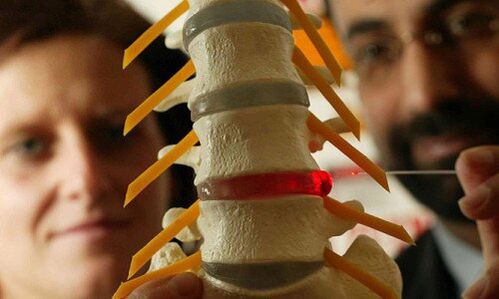
The term osteochondrosis itself is derived from two words: osteo - bone and chondrus - cartilage. Simply put, it's cartilage ossification. Although this interpretation is fundamentally wrong. Some in their delusions go even further and are confident that osteochondrosis is the deposition of salts in the joints. Furthermore, it is table salt that is supposedly consumed in large amounts in food.
Pathogenesis
In fact, everything happens a little differently. It's harder. And table salt, if it plays a role in the occurrence of osteochondrosis, is very indirect. Osteochondrosis is based on degeneration and degeneration of articular cartilage. This is not an independent disease, but a pathological process that can be seen almost anywhere there is connective cartilage tissue.
Still, osteochondrosis, in general, affects the spine. Why is that? The fact is that between the vertebrae there is a kind of cushion - intervertebral (intervertebral) discs. The physiological role of these discs is to cushion and protect the vertebral bodies from premature wear due to mechanical stress. The disc consists of an inner liquid nucleus pulposus surrounded by a fibrous ring and an upper and lower endplate.
The disk undergoes tremendous mechanical stress, causing permanent damage to its structures at the cellular level. In humans, these processes are very pronounced - this is our pay for walking upright. To prevent the disk from being completely "erased", it must constantly regenerate, that is, rebuild itself. It is the balance of damage regeneration processes that determines the normal structure of the intervertebral disc. Another curious detail is that the supply of blood and nutrients to the intervertebral discs is not made by blood vessels, which grew too large in childhood, but diffusely, from the bone tissue of the vertebral bodies. Again, payment for the ability to move on two limbs, not four.
Because of this, intervertebral discs are easily damaged anatomically and physiologically. Any negative process in the body leads to an imbalance in the balance of damage regeneration and the development of dystrophy and disc degeneration. A structurally defective disk is no longer able to withstand adequate mechanical stress. Under excessive pressure from the overlapping vertebrae, the discs are displaced in different directions, usually to the sides and posteriorly. This process is called a herniated disc.
The bone tissue of the vertebrae, which has lost its cartilaginous coating, also undergoes mechanical wear. Due to constant trauma to the surface of the anterior edge of the vertebral bodies, pathological bone growths are formed - osteophytes. Spondylosis develops. Due to disc degeneration and displacement, the intervertebral spaces shrink, the spinal canal narrows, and the spinal nerve roots in the so-called foraminal foramina are violated.
Causes
The causes, or etiological factors, of osteochondrosis are diverse. They can be local, that is, due to pathology of the spine itself, and general disturbances at the level of the organism. Any pathology that leads to a violation of the spinal structure or metabolic disturbances can be considered the cause of osteochondrosis. In this regard, there are:
- Changes in the configuration of the spine (scoliosis, pathological lordosis or kyphosis).
- Other defects of the musculoskeletal system are flat feet, narrow shoulder girdle, abnormalities in the structure of the pelvis.
- Spinal injury.
- Weak immunity.
- Metabolic disorders - osteoporosis, obesity, diabetes mellitus, thyroid disease.
- Diseases of the cardiovascular system - atherosclerosis, hypertension.
- Digestive disorders that lead to insufficient absorption of nutrients from the gastrointestinal tract.
- Heredity.
It should be noted that the above pathological conditions do not necessarily lead to osteochondrosis. This requires constant exposure to certain predisposing factors - hypothermia, malnutrition, a sedentary lifestyle or, conversely, excessive physical exertion.
Symptoms
Osteochondrosis itself is an asymptomatic process. And, at the same time, the signs of intervertebral disc degeneration are diverse. Like this? The fact is that the clinical manifestations of osteochondrosis are based on its complications - herniated discs, spondylosis, sciatica, narrowing of the spinal canal.
Furthermore, the clinic varies greatly depending on the predominant location of the process in the cervical, thoracic or lumbosacral spine. The last section is the most affected as it is the lower back that performs maximum physical activity. Signs of osteochondrosis of the lumbosacral region:
- Pain (lumbodynia, lumbago, sciatica).
- Restriction of movement in the lower back and lower limbs (intermittent claudication).
- Here, paresthesia-like sensitivity disorders - numbness, burning, chills.
- Pathological tension of the lumbar muscles.
- In the absence of treatment, disturbances in the function of Organs pelvic organs.
Cervical osteochondrosis is seen slightly less frequently than lumbosacral. However, this pathology is also quite common. In addition to the typical signs of pain (cervicalgia), decreased sensation and movement in the upper extremities, cervical osteochondrosis due to insufficient blood supply to the brain has its own characteristics. These features are manifested:
- Insomnia.
- Headache, dizziness.
- Periodic nausea.
- General weakness, rapid fatigue.
- Fluctuations in blood pressure.
- Occasionally, toothache.
- Behavioral reactions in the form of crying, irritability.
The thoracic region with osteochondrosis is affected relatively rarely. Patients in this case are people forced to sit in an awkward position fixed by occupation - students, students, programmers, office workers. The symptoms of osteochondrosis, in this case, will be as follows:
- Pain and paraesthesia in the chest.
- Dyspnea.
- Feeling of heartbeat.
- Restriction of movement in the thoracic spine.

Diagnosis
For all these reasons, it is clear that osteochondrosis is a chameleon disease. Due to the similarity of the signs, it is easy to confuse it with stroke, hypertension, myocardial infarction, angina pectoris, neurotic disorders. Therefore, to make the correct diagnosis, a comprehensive and complex diagnosis is necessary to correctly determine the symptoms and treatment of osteochondrosis.
This diagnosis, in addition to the traditional questioning and clarification of patients' complaints, should include a medical examination and special research methods. These methods include x-ray of the spine, ultrasound of internal organs. Recently, computerized imaging and magnetic resonance imaging have been used successfully to diagnose osteochondrosis.
Treatment
Therapeutic tactics for osteochondrosis involve the use of:
- Medicines.
- Massage.
- Physiotherapy procedures.
- Physiotherapy (exercise therapy).
- Manual therapy.
- Acupuncture.
The medicine for osteochondrosis has as its main objective the relief of pain and the elimination of inflammatory processes in the nerve roots. In various combinations, these drugs are widely used in the form of ointments, injections, pills for the treatment of osteochondrosis. It should not be forgotten that these medications have negative effects on the liver, stomach and intestines. Thus, they can aggravate metabolic disorders in osteochondrosis. They alleviate blockage pain well with local anesthetics. It is true that the effect of these funds is short-lived and in no way affects the course of osteochondrosis as a whole.
It is possible to improve metabolic processes at the local and body level with the help of medications such as chondroprotectors, immunostimulants and vitamins with minerals. Chondroprotectors are used in pills, ointments and ampoules. Among the fortifying agents, vitamins C, group B, are used in combination with minerals. In this regard, calcium preparations are most preferred. In fact, contrary to some erroneous statements, the basis of osteochondrosis is not an excess but only a deficiency of calcium.
After successfully relieving the exacerbation, physical therapy, massage, and exercise therapy procedures are shown. As physical procedures, we use electrophoresis with calcium, phonophoresis with hydrocortisone, ampli- tude, and paraffin. All of these measures aim to eliminate pain and inflammation in the nerve roots, ligaments and muscles. Massage for osteochondrosis is performed according to the generally accepted method. The massage zone is selected depending on the location of the osteochondrosis. Expansion of range of motion is achieved with the help of exercise therapy. In the beginning, in the exacerbation phase, there are practically no dynamic loads. The patient is constantly in an ideal posture. At this time, it is desirable to wear immobilization devices - a lumbar corset, necklace of Shants around the neck. As the exacerbation subsides, the volume and duration of movements during exercise therapy increases.
Recently, in the treatment of osteochondrosis, non-traditional methods of treatment have been received - acupuncture, manual therapy, osteopathy. Acupuncture is an effect on special biologically active points located along the spine, atria, hands and feet. With manual therapy, the normal position of the vertebrae and intervertebral discs is restored by the manual action of a specialist's hands. And in the course of osteopathy, the structural integrity of the musculoskeletal system is guaranteed through specific techniques. In the absence of the effect of conservative measures for the treatment of osteochondrosis, persistent pain, complications, surgery is indicated. The pathologically displaced disc is removed. Currently, for this purpose, microdiscectomy is performed - endoscopic removal of a displaced disc.















































